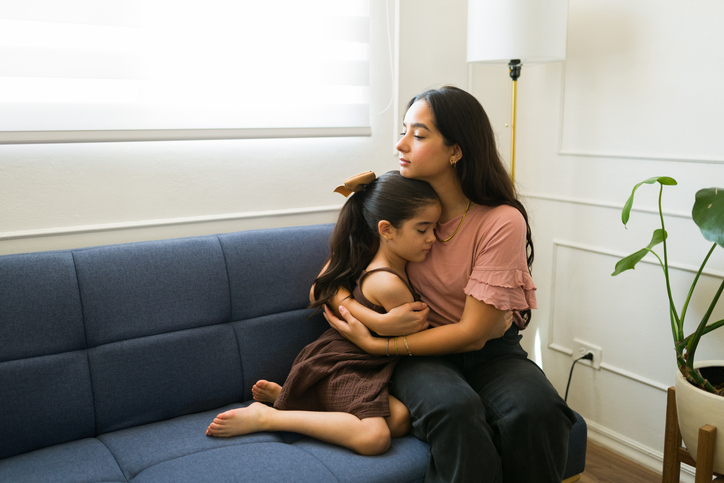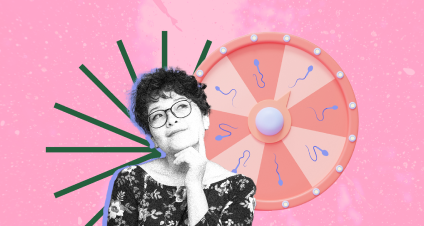Imagine you got pregnant on the first try, delivering a healthy baby girl. But then, when you tried to give your child a sibling, success would take nine and a half years, a journey to Greece, and in vitro fertilization (IVF) using donor eggs.
That’s exactly what happened to Michele Tamene, who, in 2007, gave birth to her daughter Ayana at age 37 without issue, but would then spend nearly a decade battling secondary infertility.
Secondary infertility is defined as an inability to get pregnant or carry a baby to term after someone has already experienced a healthy pregnancy and delivery, without assistance from fertility medications or treatments like IVF. This common condition affects about 11% of couples in the United States.
The years Tamene spent trying to grow her family took a deeply emotional toll on her, but she refused to give up on providing a sibling for Ayana. Read on for Tamene’s inspiring story and to learn more about the causes of secondary infertility.

The heartbreak of secondary infertility
For Tamene, the first several years of motherhood were punctuated by “doctors, drugs, acupuncture, herbs, chiropractic care, doctors' visits, and several surgeries — just to attempt to get pregnant again.”
Everywhere Tamene looked, she was constantly reminded of her secondary infertility: “Every month was a waiting game,” she tells Rescripted. At the same time, she would watch friends and family members have multiple children, “while there I sat, unable to get pregnant myself.” The next thing Tamene knew, two-year-old Ayana was voicing her desire to be a big sister: “She was pretending to be pregnant and begging for a little sister,” says Tamene. Ayana wanted a sibling so badly that she would even tell her teachers Tamene was pregnant, which led to several awkward conversations at Ayana’s school.
“I had to endure all things baby- and kid-related because I had a child,” says Tamene. “Those were the longest, hardest, and darkest years of my life. I had a child, a healthy, beautiful child, so why couldn’t I be happy?”

What causes secondary infertility?
According to the Cleveland Clinic, secondary infertility can be due to several different factors — and they can stem from either partner. Some of the most common causes are:
- Impaired sperm or impaired eggs
- Age
- Complications from a previous pregnancy
- Complications from a previous surgery
- An increase in body weight or BMI (body mass index)
- Medications or other medical conditions
- Sexually transmitted infections (STIs)
- Lifestyle factors like drinking alcohol and smoking cigarettes
For women, specifically, egg quality, structural problems with the uterus, certain health conditions, and lifestyle factors can be potential causes of secondary infertility. Considering that Tamene — who was in her 40s when she delivered her second child — ultimately pursued donor egg IVF, it’s worth exploring how egg quality and quantity can cause secondary infertility. First of all, women are born with a finite supply of eggs. As women approach their 40s, the number of eggs in the ovaries decreases, and these remaining eggs have a higher chance of having chromosomal problems.

Why pursue fertility treatments abroad?
“Over the years, I came to terms with not having a child biologically related to me,” Tamene tells Rescripted. “I just wanted a baby to love and to give Ayana a sister.” After researching fertility treatment options outside of the United States, Tamene and her family decided to travel to Athens, Greece, in November 2016 to pursue IVF with donor eggs.
According to FertilityClinicsAbroad.com, a website that helps families find Europe-based fertility clinics that meet their individual needs, countries like Greece offer IVF treatments at a fraction of the cost of what they would be in the United States. For people like Tamene, who needed donor eggs, European IVF clinics are appealing because they tend to have fewer restrictions, shorter waiting times, a more extensive database of donors, and more liberal regulations regarding donor anonymity.
While Tamene and her family were in Greece, she underwent IVF with donor eggs. “Nine days [after implantation], we found out we were pregnant, and a few weeks later, we learned that the baby was a girl,” recounts Tamene.

After returning to the United States, “Sofia Athena Tamene was delivered via a planned pre-term, medically necessary delivery at 36 weeks,” Tamene tells Rescripted. “My perfect, beautiful second daughter was born weighing in at 5 lbs 14oz. This donor egg Greek-Ethiopian baby looks just like her daddy and her sister, and she brings such joy and happiness to our lives.”
It can be difficult to accept a secondary infertility diagnosis, especially if your pregnancy went smoothly the first time around. The important thing to remember is that you are not alone; about 50% of all infertility cases are due to secondary infertility. If you’re younger than 35 and unable to conceive after one year of trying, reach out to your healthcare provider for testing and/or a referral to a fertility specialist. If you’re 35 or older, contact your provider after trying to conceive for six months with no success. Depending on your case, a fertility specialist can guide you through different treatment options, which can include IVF — and, if necessary, donor eggs.
Sarene Leeds holds an M.S. in Professional Writing from NYU, and is a seasoned journalist, having written and reported on subjects ranging from TV and pop culture to health, wellness, and parenting over the course of her career. Her work has appeared in Rolling Stone, The Wall Street Journal, Vulture, SheKnows, and numerous other outlets. A staunch mental health advocate, Sarene also hosts the podcast “Emotional Abuse Is Real.” Subscribe to her Substack, the Critical Communicator, and follow her on Instagram, BlueSky, or Threads.





.jpeg)
.jpeg)


.webp)





.jpg)













